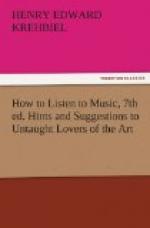“When Bach and Handel wrote their Passions, Church Cantatas, and Oratorios, they could only dream of such majestic performances as those works receive now; and it is one of the miracles of art that they should have written in so masterly a manner for forces that they could never hope to control. Who would think, when listening to the ‘Hallelujah’ of ‘The Messiah,’ or the great double choruses of ’Israel in Egypt,’ in which the voice of the composer is ’as the voice of a great multitude, and as the voice of many waters, and as the voice of many thunderings, saying, “Alleluia, for the Lord God Omnipotent reigneth!"’ that these colossal compositions were never heard by Handel from any chorus larger than the most modest of our church choirs? At the last performance of ‘The Messiah’ at which Handel was advertised to appear (it was for the benefit of his favorite charity, the Foundling Hospital, on May 3, 1759—he died before the time, however), the singers, including principals, numbered twenty-three, while the instrumentalists numbered thirty-three. At the first great Handel Commemoration, in Westminster Abbey, in 1784, the choir numbered two hundred and seventy-five, the band two hundred and fifty; and this was the most numerous force ever gathered together for a single performance in England up to that time.
[Sidenote: Choirs a century ago.]
[Sidenote: Bach’s choir.]
“In 1791 the Commemoration was celebrated by a choir of five hundred and a band of three hundred and seventy-five. In May, 1786, Johann Adam Hiller, one of Bach’s successors as cantor of the St. Thomas School in Leipsic, directed what was termed a Massenauffuehrung of ‘The Messiah,’ in the Domkirche, in Berlin. His ‘masses’ consisted of one hundred and eighteen singers and one hundred and eighty-six instrumentalists. In Handel’s operas, and sometimes even in his oratorios, the tutti meant, in his time, little more than a union of all the solo singers; and even Bach’s Passion music and church cantatas, which seem as much designed for numbers as the double choruses of ‘Israel,’ were rendered in the St. Thomas Church by a ludicrously small choir. Of this fact a record is preserved in the archives of Leipsic. In August, 1730, Bach submitted to the authorities a plan for a church choir of the pupils in his care. In this plan his singers numbered twelve, there being one principal and two ripienists in each voice; with characteristic modesty he barely suggests a preference for sixteen. The circumstance that in the same document he asked for at least eighteen instrumentalists (two more if flutes were used), taken in connection with the figures given relative to the ‘Messiah’ performances, gives an insight into the relations between the vocal and the instrumental parts of a choral performance in those days."[H]
[Sidenote: Proportion of voices and instruments.]




